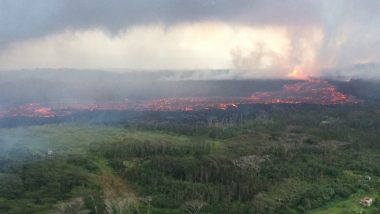There have been over 500 earthquakes in the summit area of Kilauea in the last 24 hours. This is the highest rate ever measured at the summit area, according to the United States Geological Society's Hawaiian Volcano Observatory. The strongest earthquake measuring 5.5 on the Richter scale resulted in the volcano blowing out an ash plume that reached up to 8,000 feet, according to Hawaii County Civil Defense.
The strong earthquake fortunately did not trigger a tsunami even as lava continues to bubble from the volcano. But the Hawaii Civil Defense Agency said the fallout will affect the volcano and Pahala areas, and cautioned about the possibility of aftershocks. Most earthquakes associated with the ongoing Kilauea Volcano eruption are in the magnitude 2-3 range.
The frequency of the tremors corresponded with continuous eruptions from the Kilauea volcano. The latest eruptions have left nearly a dozen people stranded in an area cut off by lava, Hawaii authorities announced Sunday.
Hawaii Civil Defense Service officials said they went through the neighbourhood to warn residents this was their last chance to evacuate before their final escape route was cut off by lava. Some chose to stay in the area, which now has no power, cell reception, landlines or county water, officials said.
Authorities are planning to airlift people out if the lava spreads farther and endangers the dozen or so holdouts. Some said they were staying because they had nowhere else to go, officials said.
Lava from a fissure near the volcano entered Kapoho Bay overnight, forcing billowing clouds of steam into the atmosphere as hot lava hit the cool water of the Pacific Ocean. The flow has prompted warnings from Hawaii County Civil Defense authorities about laze – steam formed of lava and haze that sends hydrochloric acid and volcanic glass particles into the air.
At least 87 homes have been destroyed by the Kilauea volcano eruption in the four weeks since lava began flowing from its summit. The lava from the Kilauea volcano has covered an area of 9 square kilometres -- four times as big as New York's Central Park, according to USGS.
Four weeks have passed since the first eruption rocked Hawaii's Big Island and lava continues oozing from volcanic fissures, burning homes to the ground and turning into rivers of molten rock. This eruption has lasted longer than the 1955 and 1924 eruptions, the USGS said.
(The above story first appeared on LatestLY on Jun 05, 2018 09:53 AM IST. For more news and updates on politics, world, sports, entertainment and lifestyle, log on to our website latestly.com).













 Quickly
Quickly


